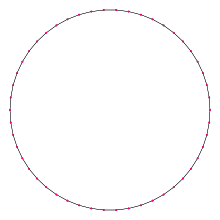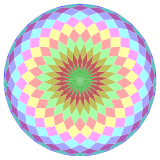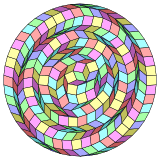Pentacontagon
| Regular pentacontagon | |
|---|---|
 A regular pentacontagon | |
| Type | Regular polygon |
| Edges and vertices | 50 |
| Schläfli symbol | {50}, t{25} |
| Coxeter diagram |
|
| Symmetry group | Dihedral (D50), order 2×50 |
| Internal angle (degrees) | 172.8° |
| Dual polygon | Self |
| Properties | Convex, cyclic, equilateral, isogonal, isotoxal |
In geometry, a pentacontagon or pentecontagon or 50-gon is a fifty-sided polygon.[1][2] The sum of any pentacontagon's interior angles is 8640 degrees.
A regular pentacontagon is represented by Schläfli symbol {50} and can be constructed as a quasiregular truncated icosipentagon, t{25}, which alternates two types of edges.
Regular pentacontagon properties
One interior angle in a regular pentacontagon is 1724⁄5°, meaning that one exterior angle would be 71⁄5°.
The area of a regular pentacontagon is (with t = edge length)
and its inradius is
The circumradius of a regular pentacontagon is
Since 50 = 2 × 52, a regular pentacontagon is not constructible using a compass and straightedge,[3] and is not constructible even if the use of an angle trisector is allowed.[4]
Symmetry

The regular pentacontagon has Dih50 dihedral symmetry, order 100, represented by 50 lines of reflection. Dih50 has 5 dihedral subgroups: Dih25, (Dih10, Dih5), and (Dih2, Dih1). It also has 6 more cyclic symmetries as subgroups: (Z50, Z25), (Z10, Z5), and (Z2, Z1), with Zn representing π/n radian rotational symmetry.
John Conway labels these lower symmetries with a letter and order of the symmetry follows the letter.[5] He gives d (diagonal) with mirror lines through vertices, p with mirror lines through edges (perpendicular), i with mirror lines through both vertices and edges, and g for rotational symmetry. a1 labels no symmetry.
These lower symmetries allows degrees of freedom in defining irregular pentacontagons. Only the g50 subgroup has no degrees of freedom but can seen as directed edges.
Dissection

Coxeter states that every zonogon (a 2m-gon whose opposite sides are parallel and of equal length) can be dissected into m(m-1)/2 parallelograms.[6] In particular this is true for regular polygons with evenly many sides, in which case the parallelograms are all rhombi. For the regular pentacontagon, m=25, it can be divided into 300: 12 sets of 25 rhombs. This decomposition is based on a Petrie polygon projection of a 25-cube.
 |
 |
 |
 |
Pentacontagram
A pentacontagram is a 50-sided star polygon. There are 9 regular forms given by Schläfli symbols {50/3}, {50/7}, {50/9}, {50/11}, {50/13}, {50/17}, {50/19}, {50/21}, and {50/23}, as well as 16 compound star figures with the same vertex configuration.
| Picture |  {50⁄3} |
 {50⁄7} |
 {50⁄9} |
 {50⁄11} |
 50⁄13 |
|---|---|---|---|---|---|
| Interior angle | 158.4° | 129.6° | 115.2° | 100.8° | 86.4° |
| Picture |  {50⁄17 } |
 {50⁄19 } |
 {50⁄21 } |
 {50⁄23 } |
|
| Interior angle | 57.6° | 43.2° | 28.8° | 14.4° |
References
- ↑ Gorini, Catherine A. (2009), The Facts on File Geometry Handbook, Infobase Publishing, p. 120, ISBN 9781438109572 .
- ↑ The New Elements of Mathematics: Algebra and Geometry by Charles Sanders Peirce (1976), p.298
- ↑ Constructible Polygon
- ↑ "Archived copy" (PDF). Archived from the original (PDF) on 2015-07-14. Retrieved 2015-02-19.
- ↑ The Symmetries of Things, Chapter 20
- ↑ Coxeter, Mathematical recreations and Essays, Thirteenth edition, p.141